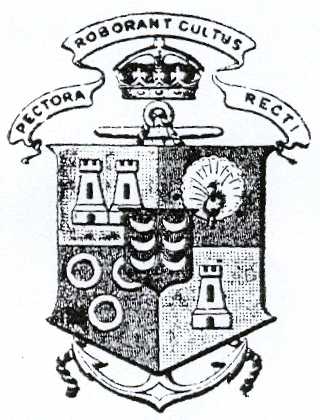

VICTORIA COLLEGE, Stellenbosch.

The arms may be blazoned:
Arms: Quarterly: I: Or, two towers gules; II: Azure, a peacock argent; III: Azure, three annulets argent, 2 and 1; IV: Or, a tower gules; Upon an inescutcheon sable, six crescents 2, 2, and 2.
The shield is ensigned of a royal crown.
Supporter: An anchor proper.
Motto: Pectora roborant cultus recti.
About the arms:
The arms are taken directly from the device borne until 1952 by the town of Stellenbosch, with two additions and and two small alterations.
The alterations are that the order of the annulets is the normal 2 and 1, instead of 1 and 2 as in the arms of the drostdij (as taken over by the town), and that the anchor supporter is upright, instead of lying at a slight angle.
One addition is the motto, which translates as “A good education strengthens the character.”
The motto scroll appears above the arms instead of below, which is unusual in the heraldry of the European Continent and even of England, but is common in Scottish heraldry. It probably derives from the influence of the Scottish rectors of the Stellenbosch Gymnasium (see below).
Lastly, a royal crown is shown above the shield. Its form appears to have been influenced by the fact that the college was named in honour of Queen Victoria.
Its appearance is by and large that of the Tudor crown, adopted in 1902 (under Edward VII) to represent royal authority. But it is drawn with low arches, recalling the miniature crown which Queen Victoria often wore. As a result, the drawing also shows a resemblance to St Edward’s crown, used since the accession of Elizabeth in 1952. This question is discussed in depth here.
About the college:
In December 1863 about 30 leading inhabitants of Stellenbosch met in the Reading Room in Dorp Street to discuss the provision of advanced education. The meeting had been called by Prof John Murray and N J Hofmeyr of the Dutch Reformed Theological Seminary, and Ds J H Neethling.
What was intended was to provide instruction in subjects required for a “refined education”, and more specifically to prepare young men for studies at the seminary, which had opened in 1859.
The outcome of the conference was the opening on 1 March 1866 of the Stellenbosch Gymnasium, in a large house in Dorp Street. It was basically a high school.
The first two principals of the institution were Scots, so the medium of instruction was English.
In 1873 the Cape Colony’s Board of Examiners was replaced by the University of the Cape of Good Hope, an examining body which did not have any role in instruction.
The result in Stellenbosch was the creation, in 1874, of faculties of Arts and of Mathematics and Physical Science, which together were called the Arts Department of the Gymnasium. Also created was an academic senate.
When the town celebrated its second centenary in 1879, a decision was taken to provide an adequate building for the college, separate from the Gymnasium. Seven years later, on 6 November 1886, the building now called the Ou Hoofgebou (old main building) was officially opened. In 1973 it was proclaimed a historical monument.
In 1881 the Arts Department received its college charter, and was named the Stellenbosch College. The Gymnasium would in future be controlled by the Town Council.
The celebration of Queen Victoria’s silver jubilee in 1887 saw the college named in her honour: Victoria College.
In 1887 an agriculture department was started, with five students and one professor. In 1898 (when there were 31 students) it was separated from the college and moved to Elsenburg. Twenty years later it was returned to the university (as the college had meanwhile become) as the Faculty of Agriculture.
Cecil John Rhodes’s ideal was that the Cape would have just one university, on the model of Oxford and Cambridge. It would be built on the Groote Schuur estate (see Rondebosch), and the medium of instruction would be English.
In 1896 Ds J H Neethling and Prof I J Marais travelled to Cape Town and made it clear that Stellenbosch would not be satisfied with a university built on the ruins of Victoria College. But for the time being, nothing came of the plan.
In spite of the agitation for a university at Stellenbosch, the college was predominantly English in its language use. The language of examinations was English, and the diplomas and certificates were all issued in English. Already in the 19th century there were complaints that “Dutch-speaking” students found it difficult to write examinations in English.
In 1910 it was announced that Sir Julius Wernher and Otto Beit had donated a large sum of money towards fulfilling Rhodes’s idea, and that a Bill would be introduced. Again Stellenbosch had to fight for its existence. The Bill was not passed, however, and it was eventually decided that there would be three universities.
As far as Stellenbosch was concerned, this dream was made possible because Jan Marais, of Coetzenburg, a former member of the Cape and Union Parliaments, had willed £100 000 for higher education in Stellenbosch. (In 1950 his statue was erected on the central campus.)
Acts passed in 1916 which became effective on 2 April 1918, elevated the South African College and Victoria College to independent universities, and the University of the Cape of Good Hope (up to this time the examining body for the colleges in Cape Town and Stellenbosch) was converted into the University of South Africa, with wider responsiblities.
These Acts were signed on the same day by the Governor-General, the one for the university at Stellenbosch being signed first, and that for Cape Town about five minutes later. So Stellenbosch University is five minutes older than the University of Cape Town.

Vir Afrikaans, kliek hier
Back to Armoria academica index
Remarks, inquiries: Mike Oettle